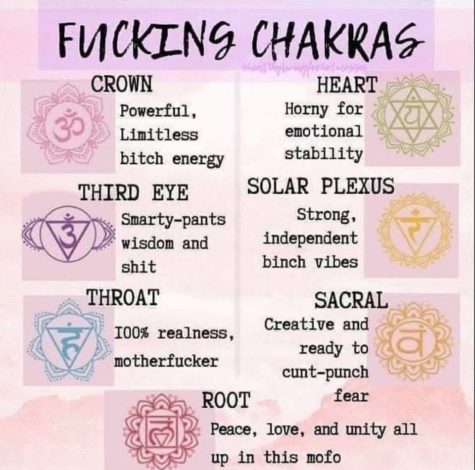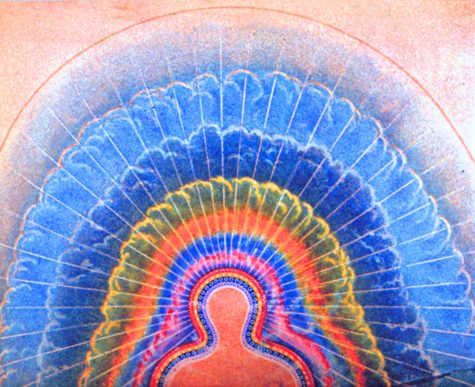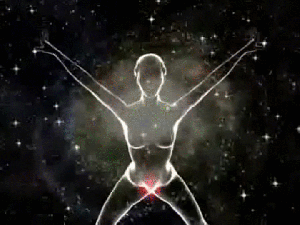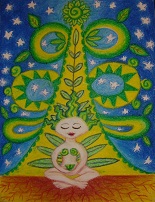Chakra Basics
The Chakras With Attitude
Kundalini and The Chakras
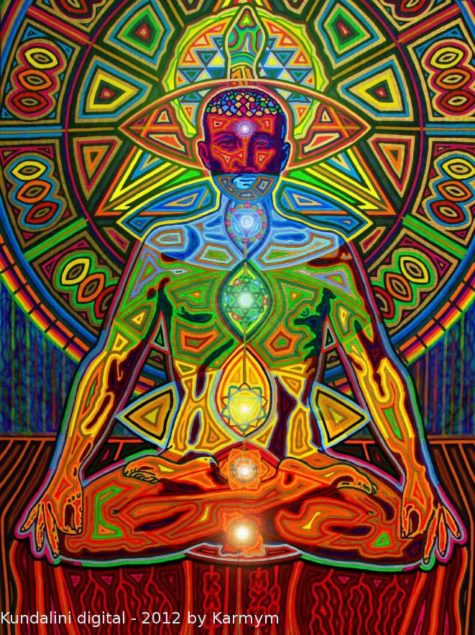
Chakras, meaning “wheel”, are psychic centers that lie along the axis of the spine as consciousness potentials. They are usually represented as lotuses. The chakras are not materially real and are to be understood as situated, not in the gross body, but in the subtle or etheric body. Repositories of psychic energies, they govern the whole condition of being.
What is most commonly known is a more recent system dating to around the eighth century C.E. with the main 7 chakras. But the ancient spiritual Indian texts refer to various other systems with variations in the number of chakras and their location.
When kundalini is struck, she awakens, uncoils and begin to rise upwards like a fiery serpent, breaking upon each chakra as she ascends, until the Shakti merges with Shiva in sahasrara chakra.
As kundalini reaches each chakra, that lotus opens and lift its flower; and as soon as she leaves for a higher chakra, the lotus closes its petals and hangs down, symbolizing the activation of the energies of the chakra and their assimilation to kundalini. The dynamization of kundalini when it passes from one chakra to another is an unfoldment of spiritual consciousness stage by stage and is said to enable the acquirement of yogic powers called siddhis.
The increasing number of lotus petals, in ascending order, may be taken to indicate the rising energy or vibration-frequencies of the respective chakras, each functioning as a transformer of energies from one potency to another. Each of the 50 petals of the first 6 chakras are associated with one of the letter of the Sanskrit alphabet.
Each of the chakras, according to the Tantras, corresponds to one of the elements of which the known world is compounded. Muladhara represents solidity; Svadhisthana, liquidity; Manipura, the gaseous; Anahata, the aerial; Vishuddha, the etheric, or space. One can see the whole process as a progressive transformation of the elements, with an increase of volatility. Each of the elements of the first five chakras are associated with a sound: Lam, Vam, Ram, Yam, Ham.
This ascent through the chakras can be viewed as an upward journey through the self which refines and subtilizes the energy that is the kundalini, until at the sixth chakra, the Ajna, center of command, a qualitative change has taken place. The chakras are centers of transformation of psychic or mental energy into spiritual energy.
Source: Tantra-Kundalini
Music and the Chakras
Music resonates the body’s energy system – the Seven Chakras. It stimulates these centers, awakening them and releasing the storehouse of creative vital force that is waiting there to be discovered, giving listeners glimpses into the deepest aspects of themselves.
There is a system for attributing specific notes to chakra energy centers. Personally, I feel that this system is arbitrary — the western temperament scale is a relatively recent development compared to the understanding of the chakra energy centers, which were first documented in the Upanishads sometime between 1200–900 BCE. Despite that arbitrariness, the system does seem to have value.
Our bodies are an electric concert of pulsating vibrational frequencies and dynamic rhythmic patterns that move with our emotions and shift with a thought. It seems natural that our organs and chakras uniquely respond to musical pitches. (I can not think of a better example than those non-invasive “sound surgeries” where kidney stones are shattered with pinpointed, high intensity sound waves.)
Aligning notes to chakras interests me; it is perfectly in accord with the principles of a vibrational universe. As Einstein says, “Everything in life is vibration.”
What follows is the list of chakras and their respective notes:
Muladhara: The “Base” or “Root” Chakra, Corresponds to the note “C”, and also the key of C. It is associated with the gonads and the adrenal medulla. Muladhara’s inner aspect governs sexuality, lust and obsession. Read More
Svadisthana: The Sacral Chakra, Corresponds to the note “D”, and also the key of D. It is associated with the testes or the ovaries that produce sex hormones. Svadisthana’s inner aspect relates to creativity and reproduction. Read More.
Manipura: The Solar Plexus Chakra, Corresponds to the note “E”, and also the key of E. It is associated with the Islets of Langerhans, which are groups of cells in the pancreas, as well as the outer adrenal glands and the adrenal cortex. Manipura’s inner aspect relates to personal power, fear and anxiety. Read More.
Anahata: The Heart Chakra, Corresponds to the note “F”, and also the key of F. It is associated with the thymus, a key element of the immune system. Anahata’s inner aspect relates to unconditional love for the self and others. Read More.
Vishuddha: The Throat Chakra, Corresponds to the note “G”, and also the key of G. It is associated with the thyroid, a gland that is produces thyroid hormone, responsible for growth and maturation. Vishuddha’s inner aspect relates to self-expression and communication. Read More.
Ajna: The “Third Eye” Chakra, Corresponds to the note “A”, and also the key of A. It is associated with the pineal gland that secretes the hormone melatonin, regulating sleep and awakening. Ajna’s inner aspect relates to the access of intuition. Read More.
Sahasrara: The Crown Chakra, Corresponds to the note “B”, and also the key of B. It is associated with the pituitary gland, the thalamus and the hypothalamus. Sahasrara’s inner aspect deals with meditation, and unity with universal consciousness. Read More.
Source: Higher Music
Everything Is Vibration
Albert Einstein once said, “Everything is vibration.” On the most fundamental levels, humans and everything else in this world (and universe, for that matter) are made of pure energetic vibrations. In fact, about 99.999% of an atom is empty space and the other .0001 % (Electrons, protons, and neutrons) are probably also made up of empty space. That means that everything we see, this computer, the table, and your body are made up of mostly empty space and the only thing that makes them material is their energetic frequency.
This is basic high school science: gas molecules vibrate at a higher frequency than liquids, and liquids vibrate faster than solids. Everything in the universe is vibrating.
Think about colors: those are simply different frequencies of visible light moving at different speeds. From slowest to fastest, these are the speeds of color vibration: Red resonates at 405-480 THz, orange at 480- 510 THz, yellow at 510-530 THz, green at 530-580 THz, blue at 600-620THz, Indigo at 620- 680 THz, and Violet at 680-790 THz.
Everything has a unique vibratory code and energy, and we should be aware of this, especially when it comes to the food that we put into our bodies! For our health, it’s important that, whenever possible, we should be eating organic food—pesticides have a low frequency vibration as they are meant to kill sentient life. Pesticides, on a vibration and physical level, lead to more disease creating free radicals in the body and having numerous harmful effects.
The ancient Vedic scriptures—the Yoga Sutras—and Buddhist theologies speak to these quantum concepts. In fact, all of Hindu and Buddhist philosophy seeks to destroy the self and the ego, to move from a place of separation/duality or an “us and them” mentality to a place of oneness with the collective, essentially in a quantum sense, turning the self into nothing in order to be one with everything.
Many cutting edge theories—including string theory and the idea of a big bang—revolve around nothingness being the source of creation for everything. Not only did these theological practices have a grand understanding of the universe, but they also had an innate understanding of light, energy and frequency. As such, they discovered that the body has 7 seven main energy centers or chakras that correspond to our emotional and physical states of well-being. The term Chakra comes from the Sanskrit word for wheel.
These Chakras—or spinning wheels of light—resonate with specific frequencies of light. There are seven colors of the rainbow and each one correlates with a chakra.
Red is the slowest frequency of visible light and thus relates to the root chakra, orange for the sacral, yellow for the solar plexus, green for the heart, blue for the throat, and indigo for the third eye, and purple for the crown chakra. As we move up the body, the vibratory frequency of the each color increases as well.
As far as foods are concerned, each chakra is related to the others, but you can focus on one specific chakra that needs attention, if you notice it is out of balance. However, it’s never a bad idea to make a big organic chakra balancing smoothie intended to harmonize the whole body. It’s an awesome way to start the day. If you are interested in the smoothies, links to the recipes can be found here: Smoothies to Open Your Chakras
By Ryan Mandell
The Chakras
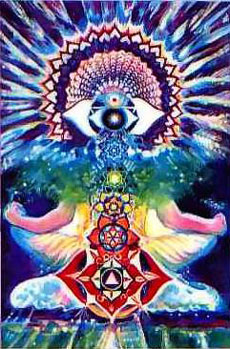 Chakras are concentrated points of energy. There are many chakras all over the body, but most healing systems focus on the seven major chakras that are placed at intervals in a line roughly corresponding to the spinal column.
Chakras are concentrated points of energy. There are many chakras all over the body, but most healing systems focus on the seven major chakras that are placed at intervals in a line roughly corresponding to the spinal column.
Some cultures picture the chakra as a spinning wheel or sun, others as a flower, a lotus or rose, its petals unfolding as the chakra is activated. Each chakra has its own color and function as laid out below:
- Root of the Spine – Red – Vitality, sex drive, personal attraction, power.
- Spleen – Orange – Will power, intelligence, logic.
- Solar Plexus – Yellow – The most important chakra. Helps control and direct energy effectively.
- Heart – Green – Love, growth, wealth, generosity, nature.
- Throat – Electric blue – Psychic change and control, creativity, healing.
- Brow – Indigo – Telepathy, mediumship, psychic communication, intuition.
- Crown of the Head – Violet – Spiritual lessons, psychic power, complete understanding fulfilment.
